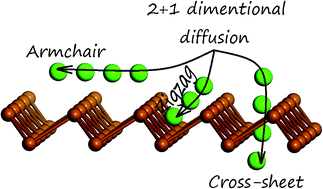Ultrafast diffusive cross-sheet motion of lithium through antimonene with 2 + 1 dimensional kinetics†
Abstract
Layered two-dimensional (2D) materials like graphene are highly appealing for lithium battery applications owing to their high surface–volume ratios. However, a critical issue that limits their practical applications is the confined motion of lithium atoms within their van der Waals gaps, which is the leading cause for battery failure due to severe clustering and phase separation. Here we demonstrate that antimonene, an exfoliatable 2D material with high structural stability, exhibits a highly mobile cross-sheet motion owing to its unique structural features. The advent of the vertically permeable channels opens a new pathway for lithium besides the normal motion along the basal plane, giving 2 + 1 dimensional kinetics. Specifically, our first-principles calculations combined with discrete geometry analysis revealed that the energy barrier for a lithium atom to diffuse across the antimonene sheet is as low as 0.36 eV, which can be further reduced to 0.18 eV under a tensile strain of 4%. These ultralow diffusion barriers across the sheet can open a new dimension for controlling the motion of lithium atoms, leading to a new paradigm for high-performance lithium batteries or inorganic solid-state lithium-ion conductors.



 Please wait while we load your content...
Please wait while we load your content...